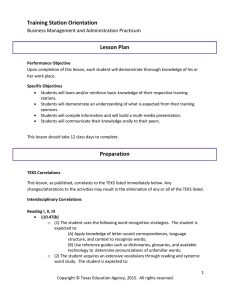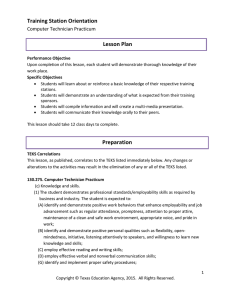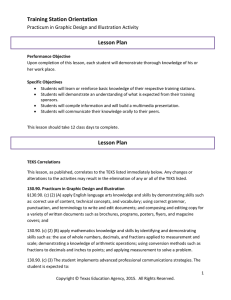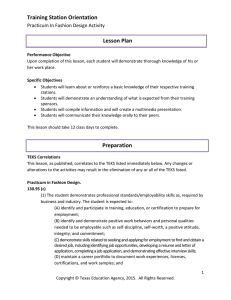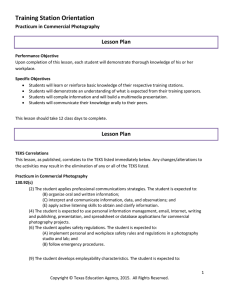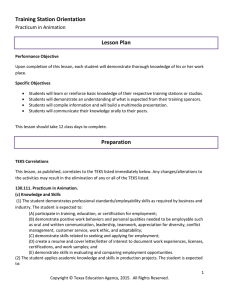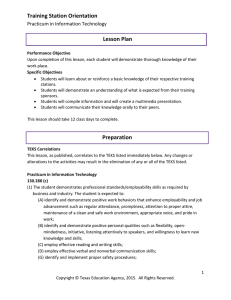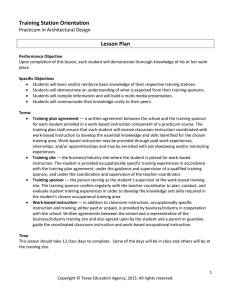Training Station Orientation Lesson Plan Practicum in Audio Video Production
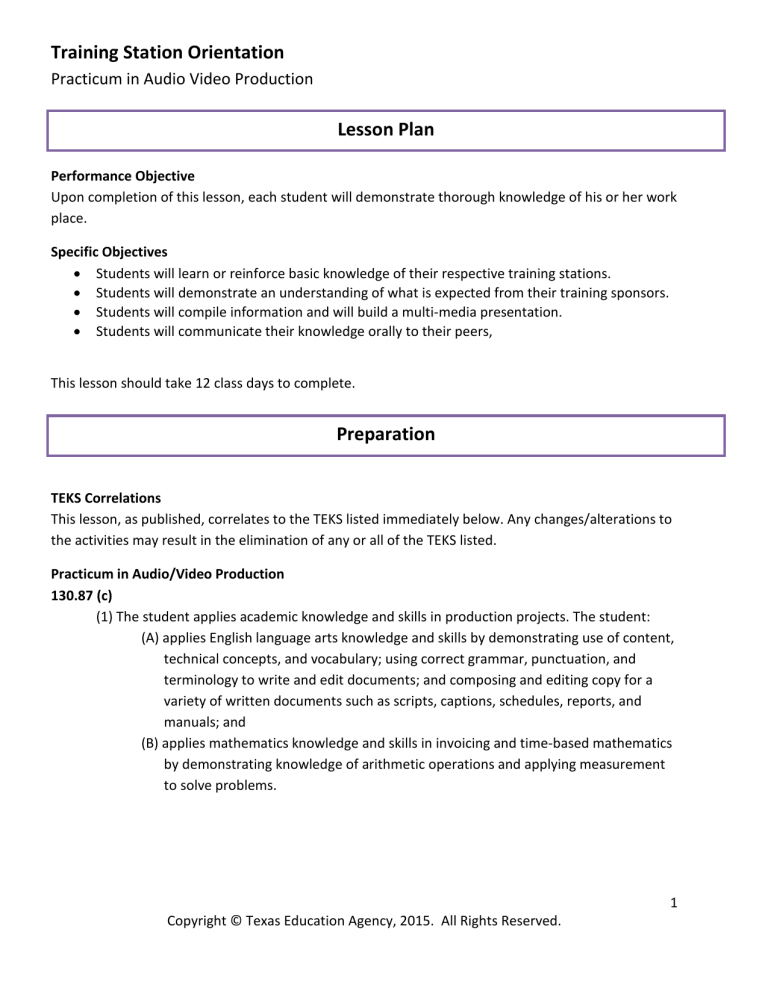
Training Station Orientation
Practicum in Audio Video Production
Lesson Plan
Performance Objective
Upon completion of this lesson, each student will demonstrate thorough knowledge of his or her work place.
Specific Objectives
• Students will learn or reinforce basic knowledge of their respective training stations.
• Students will demonstrate an understanding of what is expected from their training sponsors.
• Students will compile information and will build a multi-media presentation.
• Students will communicate their knowledge orally to their peers,
This lesson should take 12 class days to complete.
Preparation
TEKS Correlations
This lesson, as published, correlates to the TEKS listed immediately below. Any changes/alterations to the activities may result in the elimination of any or all of the TEKS listed.
Practicum in Audio/Video Production
130.87 (c)
(1) The student applies academic knowledge and skills in production projects. The student:
(A) applies English language arts knowledge and skills by demonstrating use of content, technical concepts, and vocabulary; using correct grammar, punctuation, and terminology to write and edit documents; and composing and editing copy for a variety of written documents such as scripts, captions, schedules, reports, and manuals; and
(B) applies mathematics knowledge and skills in invoicing and time-based mathematics by demonstrating knowledge of arithmetic operations and applying measurement to solve problems.
1
Copyright © Texas Education Agency, 2015. All Rights Reserved.
(2) The student implements advanced professional communications strategies. The student:
(A) adapts language for audience, purpose, situation, and intent such as structure and style;
(B) organizes oral and written information;
(C) interprets and communicate information, data, and observations;
(D) presents formal and informal presentations;
(E) applies active listening skills to obtain and clarify information;
(F) listens to and speak with diverse individuals; and
(G) exhibits public relations skills to increase internal and external customer/client satisfaction.
(3) The student implements advanced problem-solving methods. The student employs criticalthinking and interpersonal skills, including data gathering and interpretation independently and in teams to solve problems and make decisions.
(6) The student applies safety regulations. The student:
(A) implements personal and workplace safety rules and regulations; and
(B) follows emergency procedures.
(7) The student implements leadership characteristics to student leadership and professional development activities. The student:
(A) employs leadership skills to accomplish goals and objectives by analyzing the various roles of leaders within organizations, exhibiting problem-solving and management traits, describing effective leadership styles, and participating in civic and community leadership and teamwork opportunities to enhance skills;
(B) employs teamwork and conflict-management skills to achieve collective goals;
(C) establishes and maintains effective working relationships by providing constructive praise and criticism, demonstrating sensitivity to, and value for, diversity, and managing stress and controlling emotions;
(D) conducts and participates in meetings to accomplish work tasks by developing meeting goals, objectives, and agendas; preparing for, and conducting, meetings to achieve objectives within scheduled time; produces meeting minutes, including decisions and next steps; and uses parliamentary procedure, as needed, to conduct meetings; and
(E) employs mentoring skills to inspire and teach others.
(8) The student implements ethical decision-making and complies with laws regarding use of technology. The student:
(A) exhibits ethical conduct related to providing proper credit for ideas and privacy of sensitive content;
2
Copyright © Texas Education Agency, 2015. All Rights Reserved.
(B) discusses and applies copyright laws in relation to fair use and acquisition of digital information by citing sources using established methods;
(C) models respect of intellectual property when manipulating, morphing, and editing graphics, video, text, and sound;
(D) demonstrates proper etiquette and knowledge of acceptable use policies when using networks, especially resources on the Internet and intranet; and
(E) analyzes the impact of the audio/video production industry on society, including concepts related to persuasiveness, marketing, and point of view.
(9) The student demonstrates appropriate employability characteristics and maintains a professional portfolio. The student:
(A) identifies and participates in training, education, or certification to prepare for employment;
(B) identifies and demonstrates positive work behaviors and personal qualities needed to be employable such as self-discipline, self-worth, positive attitude, integrity, and commitment;
(C) demonstrates skills related to seeking and applying for employment to find and obtain a desired job, including identifying job opportunities, developing a résumé and letter of application, completing a job application, and demonstrating effective interview skills;
(D) maintains a career portfolio to document work experiences, licenses, certifications, and work samples;
(E) demonstrates skills in evaluating and comparing employment opportunities; and
(F) examines employment opportunities in entrepreneurship.
(10) The student employs effective planning and time-management skills. The student is expected to employ planning and time-management skills and tools to enhance results and complete work tasks.
Interdisciplinary Correlations
English
110.42(b)
(6) Reading/word identification/vocabulary development. The student uses a variety of strategies to read unfamiliar words and to build vocabulary. The student:
(A) expands vocabulary through wide reading, listening, and discussing; and
(B) relies on context to determine meanings of words and phrases such as figurative language, idioms, multiple meaning words, and technical vocabulary.
3
Copyright © Texas Education Agency, 2015. All Rights Reserved.
Tasks
• Students will interview employer or owner to obtain necessary information.
• Students will obtain company information from employee handouts, trade journals, or employee handbooks.
Accommodations for Learning Differences
Lessons should accommodate the needs of every learner. These lessons may be modified to accommodate your students with learning differences by referring to the files found on the Special
Populations page of this website (cte.unt.edu).
Preparation
• Secure the computer lab if you do not have immediate access to one in your classroom.
• Copy the handout sheets and rubric for the students.
Instructional Aids
• Student handouts
• Grading rubric
• Internet access
Materials Needed
• Paper for essay
• Camera or phone with camera
• Flash drive
Equipment Needed
• Computers (for students to complete project)
• Projector (for digital presentation)
• Scanner to scan pictures or materials brought to class
4
Copyright © Texas Education Agency, 2015. All Rights Reserved.
Outline
MI OUTLINE
Assignment Outline:
I.
II.
Directions: a.
The packet of information must be completed by interview, website, or handbook. b.
Minimum of 12 digital photos c.
Floor plan may be scanned
Grading: a.
Completion of packet b.
Multi-media presentation c.
Pictures d.
Professionalism during presentation
III.
Presentation must have: a.
Name and logo b.
Floor plan c.
Policies/procedures d.
Company history e.
Supervisor’s or owner’s previous experience f.
Site of company g.
Organizational chart h.
Inclusion: i.
3,2,1
IV.
Layout format must be followed
***Handout the Portfolio Guidelines (p. 193)
NOTES TO TEACHER
Copy the instructions and grading rubric and make into a packet.
Tell the class about some of the things you learned at previous jobs.
Explain how those skills helped you to become a teacher.
Explain the necessity of learning as much as possible about a job because some of the skills learned will help with future employment.
Explain to the class that customers see a business much differently than the employees see it.
Ask the class if they ever wanted to work at a place where they shopped. Have them give reasons why they wanted to work there.
Go over all the criteria in the assignment and check for understanding.
Explain the guidelines. Students can set it up while working on the
Training Station Orientation project.
5
Copyright © Texas Education Agency, 2015. All Rights Reserved.
Multiple Intelligences Guide
Application
Existentialist
Interpersonal
Intrapersonal Kinesthetic/Bodily
Logical/Mathematical
Musical/Rhythmic
Naturalist
Verbal/Linguistic Visual/Spatial
Guided Practice
Using the digital presentation, the teacher will go over the project requirements. The student will follow along and make notes on their hard copy. Students will be strongly encouraged to take the assignment packet to their job sites so employers will know about the activity.
Ask students to “map” out their plan, using a Mapping Tool from the Appendix of this document.
Give some ideas to students during the brainstorming session before the end of the first class period.
Independent Practice
• Students will work at their own pace to complete this activity.
• All work is to be done in class (with exception of interviews), so the teacher can check for understanding.
• Students are strongly encouraged to take ownership of this activity and establish time management skills for completing on time.
• Students should strive to produce the highest quality product.
• Students should be prepared to present their projects to the class.
6
Copyright © Texas Education Agency, 2015. All Rights Reserved.
Employer Project
Directions:
You are to complete this packet of information by conducting interviews with employers or managers.
If you have an employee training manual; you may use it as a source. You might even have to get some information from the company’s website.
In addition to the packet, you will include a minimum of 12 digital photos in your presentation. You may bring the pictures to class on a flash drive, a memory card or CD to import into your project.
All information will be compiled to prepare a Multi-media presentation, which will be shown to the class when you present your project.
You will be graded on:
• Completion of the packet
• Multi-media presentation
• Use of pictures (as specified)
• Professionalism during presentation, including professional dress
• **Bonus credit will be given if your employer attends your presentation!**
Presentation must have:
• Name and logo of company
• Floor Plan
• Policies and Procedures
• History of the company
• Supervisor’s (or owner’s) previous experience
• Site of company (including number of employees)
• Organizational chart
• Miscellaneous supplemental information
• Photos (either interspersed within presentation or at the end of the presentation)
If you were in charge, explain:
• 3 things you like about the training station
• 2 things you would change
• 1 thing you have learned that will help you in your career choice
This project is due on:
7
Copyright © Texas Education Agency, 2015. All Rights Reserved.
Layout Format:
1.
Student’s name
2.
Company’s name, address
3.
Type of company
4.
In a minimum of 75 words, (typed and turned in separately) state what your first day on the job was like.
5.
Procedures for reporting to work
6.
Procedures for calling in sick or calling in late
7.
Procedures for asking for time off
8.
What types of benefits are available
9.
Length of time the manager or owner has been with company
10.
What prior training did the manager or owner have?
11.
What type of education is needed for a managerial position with the company?
12.
Procedure for handling cash or legal documents (beginning and ending shifts)
13.
Procedure for accessing or handling clients files
14.
Names of competitors and their locations
15.
Organizational chart
16.
Floor plan
17.
Names of vendors and suppliers
18.
Procedures for handling returns, issuing credit, keeping clientele happy
19.
What types of jobs or careers will your current training station prepare you for?
20.
What is the procedure for handling theft (by employees or clientele)?
21.
What is the strangest thing that has happened to you on the job?
8
Copyright © Texas Education Agency, 2015. All Rights Reserved.
Summary
Review
• Why do customers see a different perspective of a business operation that that of the employees?
• Why is it important to learn as much as possible about the business establishment?
• Why are procedures established and why must they be followed?
Informal Assessment
Evaluation
• Instructor will observe students during Independent Practice
• Instructor will assist students as needed
Formal Assessment
• Use the Individual Presentation Rubric to evaluate
Copyright © Texas Education Agency, 2015. All Rights Reserved.
9
Individual Presentation Rubric
Presentation Title:
Name
ID#
Organization
Content
Knowledge
Visuals
Teacher
Date of Presentation
0-5
Audience cannot understand presentation because there is no sequence of information.
Student does not have grasp of information; student cannot answer questions about subject.
Student used no visuals.
Criteria
6-10
Audience has difficulty following presentation because student jumps around.
Student is uncomfortable with information and is able only to answer rudimentary questions.
Student occasionally used visuals that rarely support text and presentation.
11-15
Student presents information in logical sequence which audience can follow.
Student is at ease with content, but fails to elaborate.
Visuals related to text and presentation.
16-20
Student presents information in logical, interesting sequence which audience can follow.
Student demonstrates full knowledge (more than required) with explanations and elaboration.
Student used visuals to reinforce screen text and presentation.
Mechanics
Delivery
Student’s presentation had four or more spelling errors and/or grammatical errors.
Student mumbles, incorrectly pronounces terms and speaks too quietly for students in the back of the class to hear.
Presentation had three misspellings and/or grammatical errors.
Student incorrectly pronounces terms. Audience members have difficultly hearing presentation.
Presentation had no more than two misspellings and/or grammatical errors.
Student’s voice is clear. Student pronounces most words correctly.
Presentation had no misspellings or grammatical errors.
Student used clear voice and correct, precise pronunciation of terms.
Total
Teacher Comments:
Points
10
Copyright © Texas Education Agency, 2015. All Rights Reserved.

